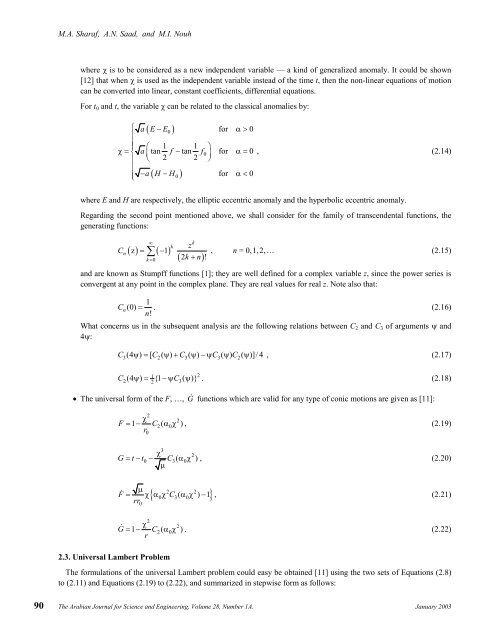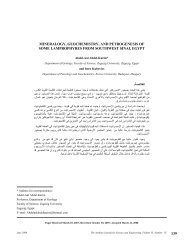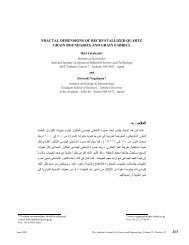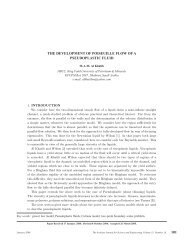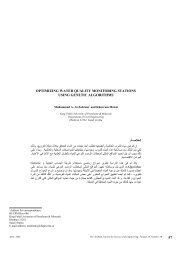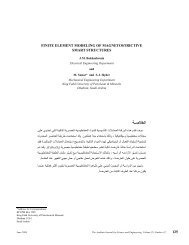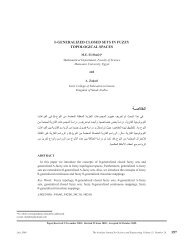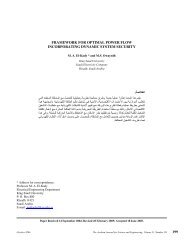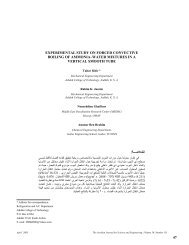lambert universal variable algorithm - Arabian Journal for Science ...
lambert universal variable algorithm - Arabian Journal for Science ...
lambert universal variable algorithm - Arabian Journal for Science ...
You also want an ePaper? Increase the reach of your titles
YUMPU automatically turns print PDFs into web optimized ePapers that Google loves.
M.A. Sharaf, A.N. Saad, and M.I. Nouh<br />
where χ is to be considered as a new independent <strong>variable</strong> — a kind of generalized anomaly. It could be shown<br />
[12] that when χ is used as the independent <strong>variable</strong> instead of the time t, then the non-linear equations of motion<br />
can be converted into linear, constant coefficients, differential equations.<br />
For t0 and t, the <strong>variable</strong> χ can be related to the classical anomalies by:<br />
( )<br />
⎧ a E−E0<strong>for</strong> α > 0<br />
⎪<br />
⎪ ⎛ 1 1 ⎞<br />
χ= ⎨ a⎜tan f −tan f0<strong>for</strong><br />
α= 0<br />
2 2<br />
⎟<br />
, (2.14)<br />
⎪ ⎝ ⎠<br />
⎪<br />
⎪⎩<br />
−a( H −H0) <strong>for</strong> α < 0<br />
where E and H are respectively, the elliptic eccentric anomaly and the hyperbolic eccentric anomaly.<br />
Regarding the second point mentioned above, we shall consider <strong>for</strong> the family of transcendental functions, the<br />
generating functions:<br />
C<br />
n<br />
∞<br />
( z) = ∑ ( −1)<br />
k = 0<br />
k<br />
k<br />
z<br />
, n = 0,1,2,… (2.15)<br />
2 !<br />
( k + n )<br />
and are known as Stumpff functions [1]; they are well defined <strong>for</strong> a complex <strong>variable</strong> z, since the power series is<br />
convergent at any point in the complex plane. They are real values <strong>for</strong> real z. Note also that:<br />
1<br />
Cn(0)<br />
= . (2.16)<br />
n !<br />
What concerns us in the subsequent analysis are the following relations between C2 and C3 of arguments ψ and<br />
4ψ:<br />
C (4 ψ ) = [ C ( ψ ) + C ( ψ) −ψC ( ψ) C ( ψ)]/4<br />
, (2.17)<br />
3 2 3 3 2<br />
1<br />
2 2 3<br />
2<br />
C (4 ψ ) = {1 −ψC ( ψ)}<br />
. (2.18)<br />
• The <strong>universal</strong> <strong>for</strong>m of the F, …, G functions which are valid <strong>for</strong> any type of conic motions are given as [11]:<br />
2<br />
χ<br />
2<br />
F = 1 − C2(<br />
α0χ) , (2.19)<br />
r<br />
0<br />
3<br />
χ<br />
2<br />
G = t−t0 − C 3( α0χ) , (2.20)<br />
µ<br />
0<br />
2 2<br />
{ 0 3( 0 ) 1}<br />
F<br />
µ<br />
= χ α χ C α χ −<br />
rr<br />
2.3. Universal Lambert Problem<br />
2<br />
, (2.21)<br />
G<br />
χ<br />
2<br />
= 1 − C2(<br />
α0χ) . (2.22)<br />
r<br />
The <strong>for</strong>mulations of the <strong>universal</strong> Lambert problem could easy be obtained [11] using the two sets of Equations (2.8)<br />
to (2.11) and Equations (2.19) to (2.22), and summarized in stepwise <strong>for</strong>m as follows:<br />
90 The <strong>Arabian</strong> <strong>Journal</strong> <strong>for</strong> <strong>Science</strong> and Engineering, Volume 28, Number 1A. January 2003


